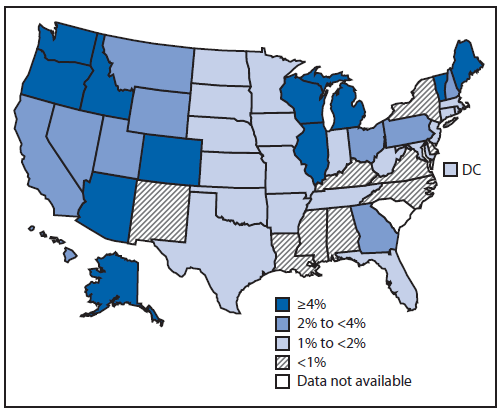
Morbidity and Mortality Weekly Report (MMWR) CDC:
State and local school vaccination requirements are implemented to maintain high vaccination coverage and minimize the risk from vaccine preventable diseases (1). To assess school vaccination coverage and exemptions, CDC annually analyzes school vaccination coverage data from federally funded immunization programs. These awardees include 50 states and the District of Columbia (DC), five cities, and eight U.S.-affiliated jurisdictions.* This report summarizes vaccination coverage from 48 states and DC and exemption rates from 49 states and DC for children entering kindergarten for the 2012-13 school year. Forty-eight states and DC reported vaccination coverage, with medians of 94.5% for 2 doses of measles, mumps, and rubella (MMR) vaccine; 95.1% for local requirements for diphtheria, tetanus toxoid, and acellular pertussis (DTaP) vaccination; and 93.8% for 2 doses of varicella vaccine among awardees with a 2-dose requirement. Forty-nine states and DC reported exemption rates, with the median total of 1.8%. Although school entry coverage for most awardees was at or near national Healthy People 2020 targets of maintaining 95% vaccination coverage levels for 2 doses of MMR vaccine, 4 doses of DTaP†vaccine, and 2 doses of varicella vaccine (2), low vaccination and high exemption levels can cluster within communities, increasing the risk for disease. Reports to CDC are aggregated at the state level; however, local reporting of school vaccination coverage might be accessible by awardees. These local-level data can be used to create evidence-based health communication strategies to help parents understand the risks for vaccine-preventable diseases and the benefits of vaccinations to the health of their children and other kindergarteners.
Vaccination coverage among children entering kindergarten is assessed annually by awardees. Each school year, the health department, school nurse, or other school personnel assess the vaccination and exemption status of a census or sample of kindergarteners enrolled in public and private schools to determine vaccination coverage, as defined by state and local school requirements established to protect children from vaccine-preventable diseases. Among the 50 states and DC, 43 awardees used an immunization information system (IIS) as at least one source of data for some of their school assessment. To collect data, 33 awardees used a census of kindergarteners; 11 a sample of schools, kindergarteners, or both; two a voluntary response of schools; and five a mix of methods. Results of the school-level assessments are reported to the health department. Aggregated data are reported to CDC for public and private schools. Data for homeschooled students were not reported to CDC. All estimates of coverage and exemption were weighted based on each awardee’s response rates and sampling methodology, unless otherwise noted. Of the 50 states and DC, 12 awardees met CDC standards for school assessment methods in 2012-13.§
